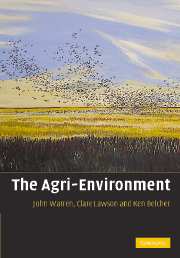Book contents
- Frontmatter
- Contents
- Preface and Acknowledgements
- 1 An introduction to agro-ecology
- 2 Agricultural support and environmentalism
- 3 Environmental impacts of agriculture
- 4 Principles behind agri-environment schemes
- 5 Farm conservation planning
- 6 Habitat management
- 7 The management of agricultural wastes
- 8 Low-impact farming systems
- 9 Landscape and farmscape ecology
- 10 The future of agri-environmental systems
- Glossary
- References
- Index
2 - Agricultural support and environmentalism
Published online by Cambridge University Press: 08 December 2009
- Frontmatter
- Contents
- Preface and Acknowledgements
- 1 An introduction to agro-ecology
- 2 Agricultural support and environmentalism
- 3 Environmental impacts of agriculture
- 4 Principles behind agri-environment schemes
- 5 Farm conservation planning
- 6 Habitat management
- 7 The management of agricultural wastes
- 8 Low-impact farming systems
- 9 Landscape and farmscape ecology
- 10 The future of agri-environmental systems
- Glossary
- References
- Index
Summary
Introduction
This chapter outlines some of the key events in agricultural policy from the beginning of the twentieth century until the recent reforms of the European Common Agricultural Policy (CAP) in 2003, the 2002 US Farm Bill and ongoing world trade negotiations. It describes the widespread introduction of subsidies to support farm prices and the unprecedented expansion of agricultural production, to the advent of food surpluses and concerns over the environmental impact of modern agricultural practices. The development of agri-environment measures and the change in emphasis from an agricultural policy that supports production agriculture to one that supports the environment and rural development is explained and the principles behind agri-environment measures examined.
Agricultural policy: the start of government intervention
The regulation of agricultural markets and intervention by national governments to support farm incomes is not a new phenomenon. Throughout the course of history national governments employed various policies to support and protect agricultural production, such as the Corn Laws designed to protect British cereal farmers from foreign imports. However, it was not until the long-lasting economic depression of the 1920s and 1930s, which was also a period of agricultural depression with low commodity prices and depressed farm incomes, that national governments systematically intervened in agricultural markets to ensure the home production of food and to support their national industries.
- Type
- Chapter
- Information
- The Agri-Environment , pp. 19 - 41Publisher: Cambridge University PressPrint publication year: 2007



